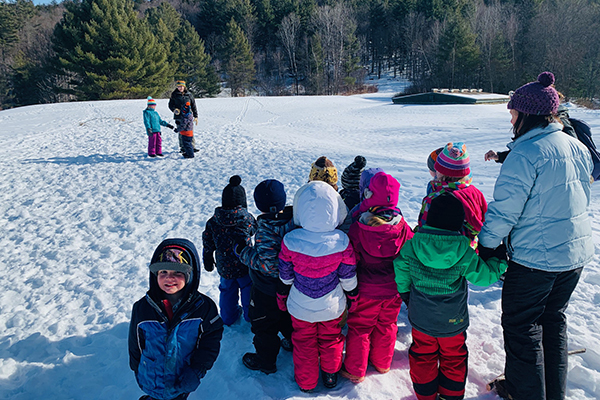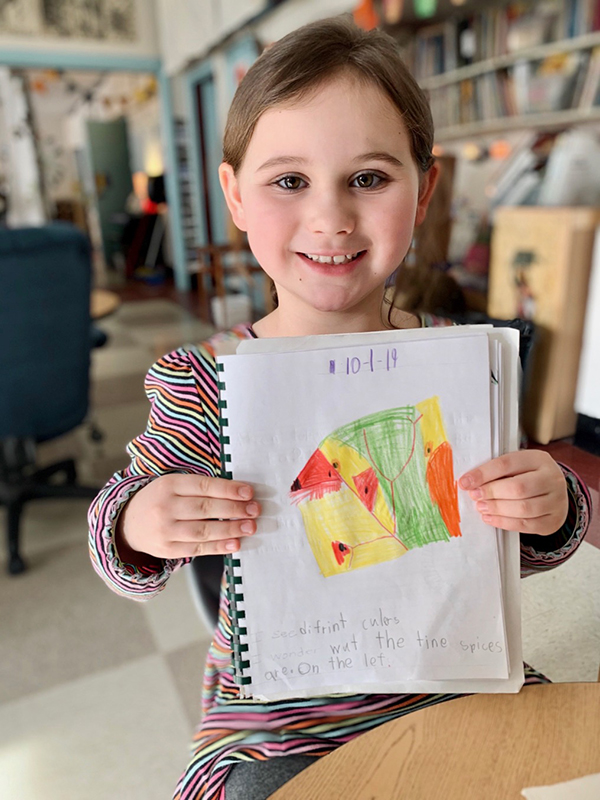“Everybody’s gonna learn to read. But not everyone is going to come out of school feeling like, ‘I’m brave. I’m kind. I help my friends,’” said Leslie Polubinski, discussing the impact that the ECO (Educating Children Outdoors) program had on her kids. “That makes me motivated to spread the word about this program. We do have significant money to raise and we’re gonna have to raise it every year,” said Polubinski.
Polubinski is on the fundraising board for the ECO Forest Festival, an outdoor fundraiser for Moretown’s ECO program. The event, hosted by Moretown Elementary School on Saturday, February 15, is free, but donations will be accepted. It’s part festival, part sneak peek into what Moretown students are doing every day in the ECO program at school.
NATURE IMMERSION
ECO is a nature-immersion program that takes pre-K through second-grade Moretown students outside for several hours on a weekly basis. These outdoor excursions are led by classroom teachers and trained nature educators from North Branch Nature Center, a nonprofit for outdoor learning. As stated on the ECO Forest Festival website, in outdoor ECO classrooms “desks are replaced by stumps and logs; students focus on the campfire instead of the blackboard; pens and computers are traded for tools such as saws, shovels and sticks.”
Speaking to The Valley Reporter, Polubinski explained why the ECO program means so much to her and her two kids. “There was one day … it was a gross rainy day in early November. It was cold and raw. I thought, there’s no way the kids went outside for ECO today. I go to pick up Ella from preschool and say, ‘Gosh, you guys went outside for ECO? Was it horribly cold?’ and she says, ‘No! We’re brave preschoolers!’ Then it all kind of clicked for me. I thought, this is the foundation of a narrative about themselves. Clearly, they had rallied around the fact that they were going out in this terrible weather and that they could do it together, because they were brave preschoolers and brave people.”
SELF-EFFICACY
For Polubinski, the value of the ECO program comes from how it infuses children with a sense of self-efficacy. “As a kid, when you have these experiences over and over again, that becomes a narrative about yourself and your life,” said Polubinski, who noticed a change in her daughter Ella’s confidence after just a few weeks of the ECO program. “After a few weeks of ECO, I noticed a huge difference in my daughter’s comfort level with exploring the outdoors, in particular with climbing and being intrepid in the woods. She’ll say, ‘Let’s go climb this boulder! I’ll be the leader!’”
BEST PART
For the ECO teachers, one of the best parts of facilitating the ECO program is watching the kids develop a tendency for teamwork. “The teachers have said that the kids transform when they get out of the classroom. There are kids that don’t even talk to each other when they’re in the school, then, all of a sudden, those kids are building a snow fort together. Those sorts of experiences are where the teachers really see the magic,” said Polubinski.
Polubinski’s emphasis on the “magic” of outdoor learning certainly reflects the scientific consensus regarding the benefits of outdoor play for childhood development. A 2018 article from Harvard Health Publishing claims that spending time outdoors helps children develop executive function (aka the skills that help people plan, prioritize, negotiate and multitask), learn to take risks, improve socialization skills and foster an appreciation of nature. An article from the National Association for the Education of Young Children (NAEYC), cites research stating that outdoor play “invites children to learn science,” “creates opportunities for social interaction and collaboration,” “promotes physical health,” “invites new contexts for learning,” “gives children a chance to take appropriate risks,” “supports STEM skills,” “anchors children in the real world,” and even “leads to better learning outcomes once children return to other activities.”
Eager to see this outdoor learning for myself, this reporter went to Moretown Elementary School to join preschoolers as they marched off to ECO camp. “Can I hol’ yo hand?” one very bundled up little girl asked trudging up a snowy hill into the woods. On the way to camp, a fire pit surrounded in tree-stump seats, the little girl explained her favorite ECO activity: shaving sticks.
What that day revealed was a fury of little-kid energy being absorbed by the forest, along with an outpouring of curiosity being cast upon the snow, rocks and trees. “I’m making snow sugar!” one girl said as she shook a pot full of snow over a pretend stove in the “snow kitchen.” “I’m a gray wolf!” yelled a little boy before scuttling away on all fours. “What do gray wolves eat?” he wanted to know. Another pair of boys was carrying a bucket full of supplies to the camp. “We don’t need help! We got it!” they boasted as they teetered along.

LOT OF PLAY
There was a whole lot of play during preschool ECO, so to get a sense of the more academic second-grade perspective of the ECO program it was time to find the teachers. Pam Dow, first- and second-grade teacher and creator of the ECO program, said that the older grades spend less time doing free play and more time doing group projects at ECO. Every day before ECO, second-graders see a photo of a nature object projected on the wall, sketch it, write scientific questions about it, and then go outside and try to find it in nature.
With Pam Dow a second-grader named Julia Hill was interviewed about her ECO experience. “Once, we were learning about solid, liquid and gas. We watched a few videos and then we came up in the forest. And then we put lots of snow in a bag, and then me and my partners tried to unfreeze the snow. We were trying to change a solid into a liquid. And we were the only team that actually did it!”
She was asked how she did it.
“First, we were tossing around the bag and then we breathed into it. Then we putted it on Graham’s head, in his hat. Then, we kneaded it and made it turn into liquid.”
Julia recalled another ECO contest that she and her teammates had conquered. Doing a lesson on insultation and how insulation can maintain temperatures, students were charged with the task of taking a small stuffed animal and creating a well-insulated home for it.
“We made an animal shelter,” said Julia. “And I think we got the highest.”
“The highest what?” Dow asked her.
“The highest amount of temperature. We made a little hole and then putted the animal in the little hole with a thing that measures temperature and covered it with sticks and grass and logs, and pinecones for air fresheners, and then we put pine needles and a little bit of dirt on top, and that was making insulation. And our amount was 40,” said Julia.
“The internal temperature of your shelter was 40 degrees?” asked Dow.
“Yeah. And the outside temperature was 30-something. It was warmer in the home then it was outside.”
Julia was asked what she liked about ECO. “I love the outdoors and animals,” she said. “I love ’em. They’re just really important. Cuz if we didn’t have animals, what would happen? And outside … you do more action outside and its fresh air. I love being outside.”
Before leaving, Julia brought out one of her scientific sketches. It was a close-up of a leaf.







